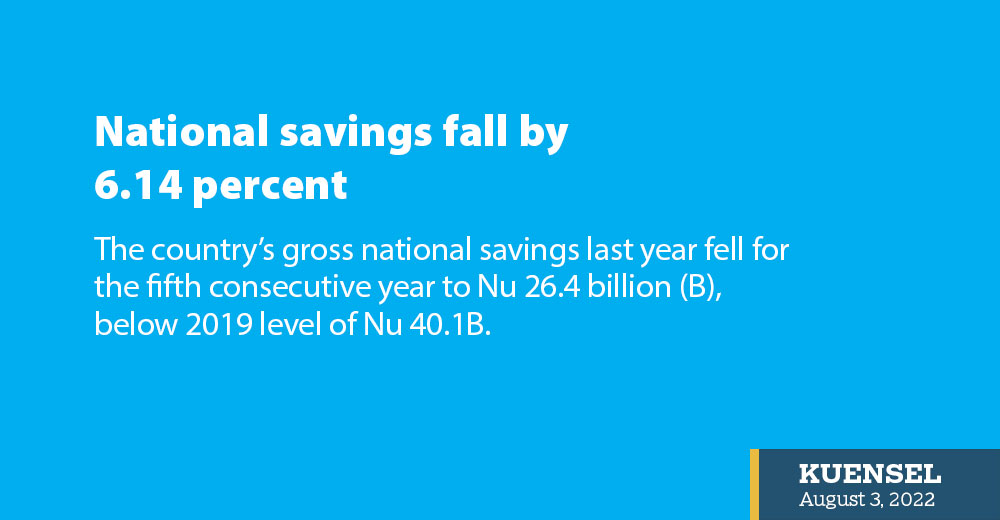…enough to finance only 39 percent of domestic investment
Thukten Zangpo
The country’s gross national savings last year fell for the fifth consecutive year to Nu 26.4 billion (B), below 2019 level of Nu 40.1B.
In 2021, it saw a drop by Nu 2.4B from Nu 28.8B the year earlier. This, according to the National Statistics Bureau’s (NSB) 2022 report, is down by 6.14 percent.
Last year’s national savings was equivalent to 15.39 percent of gross domestic product (GDP). It was 16.73 percent in 2020 and 22.48 percent in 2019.

Of the total national saving, government savings declined sharply to -Nu 6.3B in 2021 from Nu -23.2 million (M) in 2020.
The pandemic continued to weigh on the country’s national savings.
However, private savings, which include households, private and public corporations, increased to Nu 32.7B, which is an increase of 3.9B from the previous year.
National saving is the difference between a nation’s disposable income and what it spends on the consumption of goods and services—it comprises household, corporate, and government savings.
It also indicates a nation’s financial health and provides a source of funds for domestic investment, which in turn is a key driver of labour productivity and living standards.
According to the report, the consistent increase in the government’s final consumption expenditure with the declining inflow of loans and grants from abroad has resulted in a fall in national savings. “The gross national savings could not meet the investment requirements of the economy.”
In an economy open to trade and capital flows, the difference between the level of investment and saving in the economy is equal to the current account balance.
Over the years, Bhutan’s investment has tended to exceed savings since the country operates on both trade and current account deficits.
With a nominal investment of Nu 67.3B against a gross national saving of Nu 26.4B in 2021, the country saw a current account deficit of Nu 40.9B.
In real terms, the investment recorded an increase of 12.6 percent in 2021 against a drop of 15.99 percent in 2020, up by 28.59 percentage points compared to the previous year.
According to the NSB, the final consumption expenditure recorded a growth of 5.06 percent in 2021 compared to a contraction of 4.34 percent from the year earlier.
In nominal terms, it saw an increase of 15.9B to Nu 159.8B.
The private final consumption expenditure, which accounts for 74.53 percent of the final consumption expenditure growth, accelerated to 4.85 percent from a drop of -6.77 in 2020. In current terms, private final consumption expenditure was estimated at Nu 119.1B. Its share of GDP stood at 63.41 percent with an increase of 0.72 percentage points during the year.
The government’s final consumption expenditure which accounted for 25.47 percent of the total final consumption expenditure saw a growth of 5.73 percent at Nu 40.7B. It was an increase of 4.7B from 2020 at current prices.
The saving-investment ratio was 0.39 last year, compared to 0.51 in 2020.
“The national savings was able to finance only 39 percent of domestic investment against 51 percent in 2020,” the report stated.


